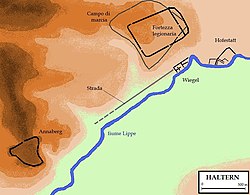Aliso Castrum Aliso | |
|---|---|
Fortified camp | |
 Principia, command post of the Roman military site | |
 Remains | |
| Coordinates: 51°44′22″N7°10′14″E / 51.73944°N 7.17056°E | |
| Country | Germany |
| State | North Rhine-Westphalia |
| District | Recklinghausen |
| Municipality | Haltern am See |
Aliso was a military and civilian colony in ancient Germany, built by the emperor Augustus near present-day Haltern am See, when he wanted to create the Roman province of Germania.
Contents
After the Battle of the Teutoburg Forest in 9 AD, Aliso was the last point of resistance of the Roman troops in Germania. Besieged by the Germans under Arminius, the garrison commanded by the prefect Lucius Caedicius put up a fierce resistance before managing to escape and regain the Roman limes.


